Observation and Measurement of Electric Wires Using Digital Microscopes
Electric wire is a generic term for metal wires that transmit electric power and signals. Electric wires can be categorised into power line wires and communication wires according to the intended use. This section provides an overview of electric wires and introduces examples of how to observe and measure them using a digital microscope.
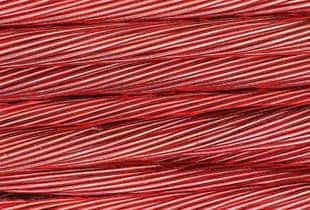
- Differences between Electric Wires and Cables
- Conductor Materials and Characteristics
- Differences in Regulations for Electric Wire Cross-sectional Areas between Japan and the United States
- Cross-sectional Areas and Allowable Currents of Electric Wires
- Electric Wire Observation and Measurement Examples Using Digital Microscopes
Differences between Electric Wires and Cables
Electric wire is a generic term for metal wires that conduct electricity. Some wires are categorised as cables based on structural differences.
- Electric wire (isolated wire)
- An electric wire is a conductor, which transmits electricity, that is covered with an insulator, which does not transmit electricity.
- Cable
- A cable is a bundle of electric wires covered with a sheath.
- A: Conductor
- B: Insulator
- C: Sheath
- D: Filler
- E: Binder tape
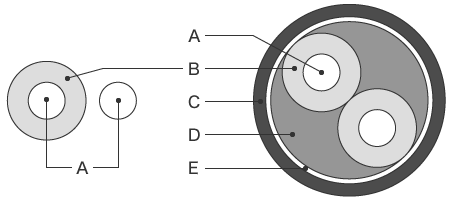
Conductor Materials and Characteristics
Almost all conductors used for electric wires and cables are made from copper or aluminium.
Based only on conductivity, silver and gold are also good materials. However, these materials are rarely used because they are expensive.
| Material | Conductivity (% according to the International Annealed Copper Standard (IACS)) | Resistivity (10-6 Ωm) |
|---|---|---|
| Ag (silver) | 106.4 | 0.0162 |
| Cu (copper) | 100 | 0.0172 |
| Au (Gold) | 71.8 | 0.024 |
| Aluminium (Al) | 61.7 | 0.0275 |
Characteristics of copper and aluminium
Copper and aluminium conductors used for electric wires and cables have the following characteristics.
- Copper
-
- Copper conducts electricity very easily with its very high conductivity.
- Copper basically does not oxidise in dry air at room temperature.
- Copper is generally used as the conductor in commonly used cables.
- Aluminium
-
- The density of aluminium is lower than copper, with a weight of one-third that of copper. This light material is suitable for long-distance applications such as power lines.
- When aluminium oxidises, the surface is covered with an alumina layer, which is resistant to corrosion.
- Aluminium is cheap and available at around one-third to half the price of copper.
Differences in Regulations for Electric Wire Cross-sectional Areas between Japan and the United States
In Japan, the cross-sectional areas of electric wires (stranded wires) are regulated with the Japanese Industrial Standards (JIS). The unit is SQ, which originated from an English measure for cross-sectional areas, square millimetre. The UL standards in the United States use American wire gauge (AWG). The table below shows conversions between AWG (UL) and SQ (JIS).
| Wire gauge (UL standards) | Outer diameter (mm) | Cross sectional area (mm2) | Corresponding SQ size (JIS) |
|---|---|---|---|
| AWG 4/0 | 11.68 mm | 107.2 mm2 | 100 SQ |
| AWG 3/0 | 10.40 mm | 85.03 mm2 | 80 SQ |
| AWG 2/0 | 9.266 mm | 67.42 mm2 | 60 SQ |
| AWG 1/0 | 8.254 mm | 53.49 mm2 | 60 SQ |
| AWG 1 | 7.348 mm | 42.41 mm2 | 38 SQ |
| AWG 2 | 6.543 mm | 33.63 mm2 | 38 SQ |
| AWG 4 | 5.189 mm | 21.15 mm2 | 22 SQ |
| AWG 6 | 4.115 mm | 13.30 mm2 | 14 SQ |
| AWG 8 | 3.264 mm | 8.37 mm2 | 8 SQ |
| AWG 10 | 2.588 mm | 5.26 mm2 | 5.5 SQ |
| AWG 12 | 2.052 mm | 3.31 mm2 | 3.5 SQ |
| AWG 14 | 1.628 mm | 2.08 mm2 | 2 SQ |
| AWG 16 | 1.290 mm | 1.31 mm2 | 1.25 SQ |
| AWG 18 | 1.024 mm | 0.823 mm2 | 0.75 SQ |
| AWG 20 | 0.8128 mm | 0.519 mm2 | 0.5 SQ |
| AWG 22 | 0.6426 mm | 0.324 mm2 | 0.3 SQ |
| AWG 24 | 0.5105 mm | 0.205 mm2 | 0.2 SQ |
| AWG 26 | 0.4039 mm | 0.128 mm2 | 0.12 SQ |
| AWG 28 | 0.3200 mm | 0.0804 mm2 | 0.08 SQ |
| AWG 30 | 0.2540 mm | 0.0507 mm2 | 0.05 SQ |
Cross-sectional Areas and Allowable Currents of Electric Wires
The larger the cross-sectional area of an electric wire, the larger the allowable current.
The following table shows the allowable currents of typical copper wires.
| Diameter (mm) | Allowable current (A) |
|---|---|
| 1 mm | 16 |
| 1.2 mm | 19 |
| 1.6 mm | 27 |
| 2 mm | 35 |
| 2.6 mm | 48 |
| 3.2 mm | 62 |
| 4 mm | 81 |
| 5 mm | 107 |
| Cross sectional area (mm2) | Allowable current (A) |
|---|---|
| 0.9 | 17 |
| 1.25 | 19 |
| 2 | 27 |
| 3.5 | 37 |
| 5.5 | 49 |
| 8 | 61 |
| 14 | 88 |
| 30 | 139 |
| 50 | 190 |
| 100 | 298 |
| 200 | 469 |
| 400 | 745 |
| 600 | 930 |
| 800 | 1080 |
| 1000 | 1260 |
Electric Wire Observation and Measurement Examples Using Digital Microscopes
These are the latest examples of observation and measurement of electric wires using KEYENCE’s VHX Series 4K Digital Microscope.

The diffuse attachment allows for observation with no glare.
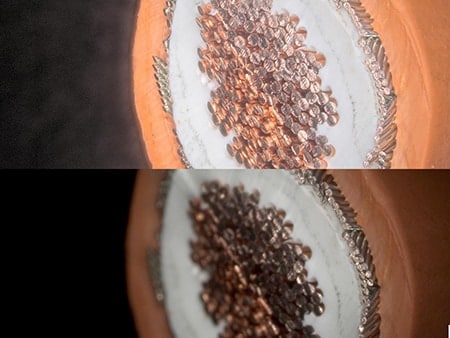
Lower: Normal image, Upper: Depth composition + HDR image
The HDR function allows for detailed observation of cable cross-sections.
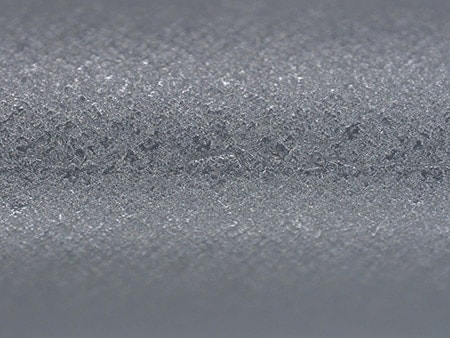
Normal image
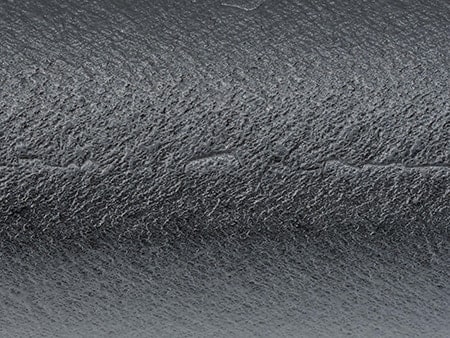
Optical Shadow Effect Mode image
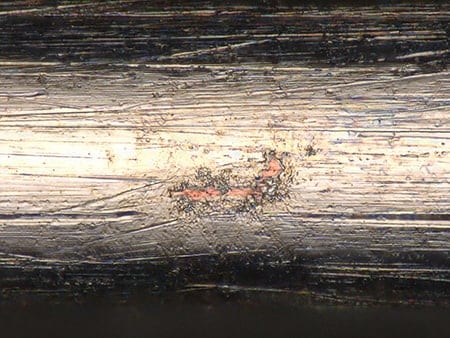
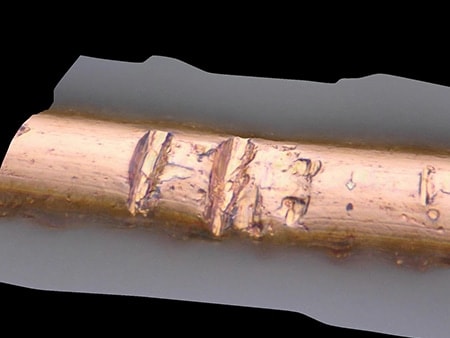
The 3D depth composition function allows for accurate observation of defect shapes.
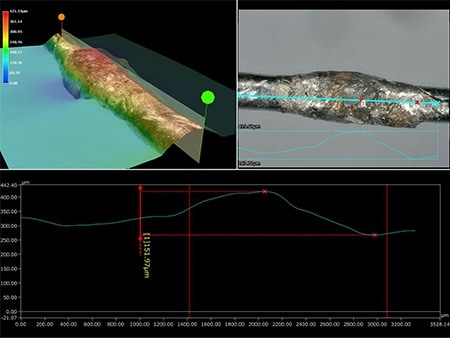
The weld metal that rises above the surface can be quantified using the 3D measurement function, which allows for accurate OK/NG judgement.
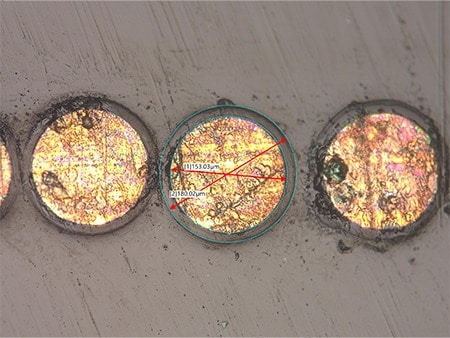
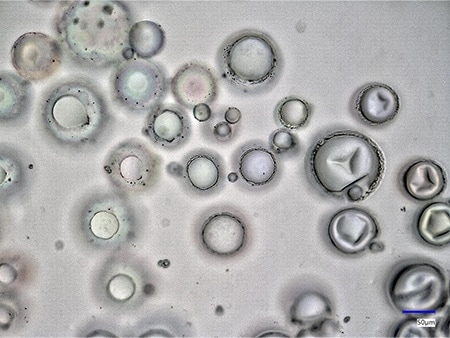

Automatic area measurement image
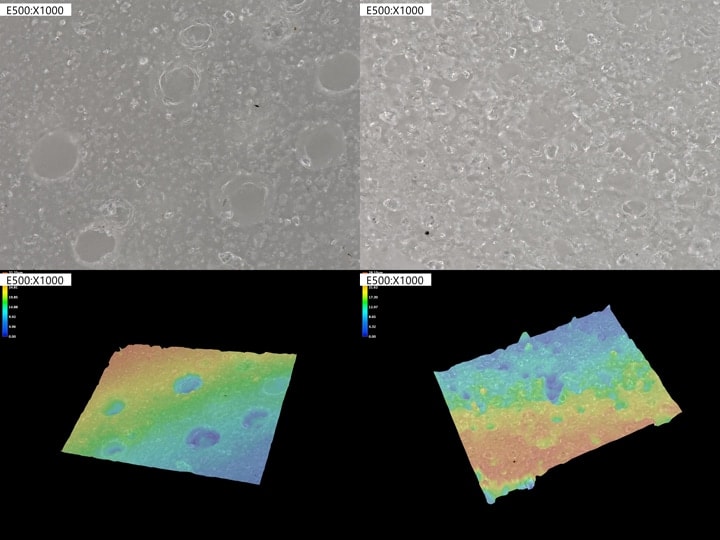
Differences of surface conditions caused by differences in materials and manufacturing conditions can be visualised using the 3D depth composition function.


